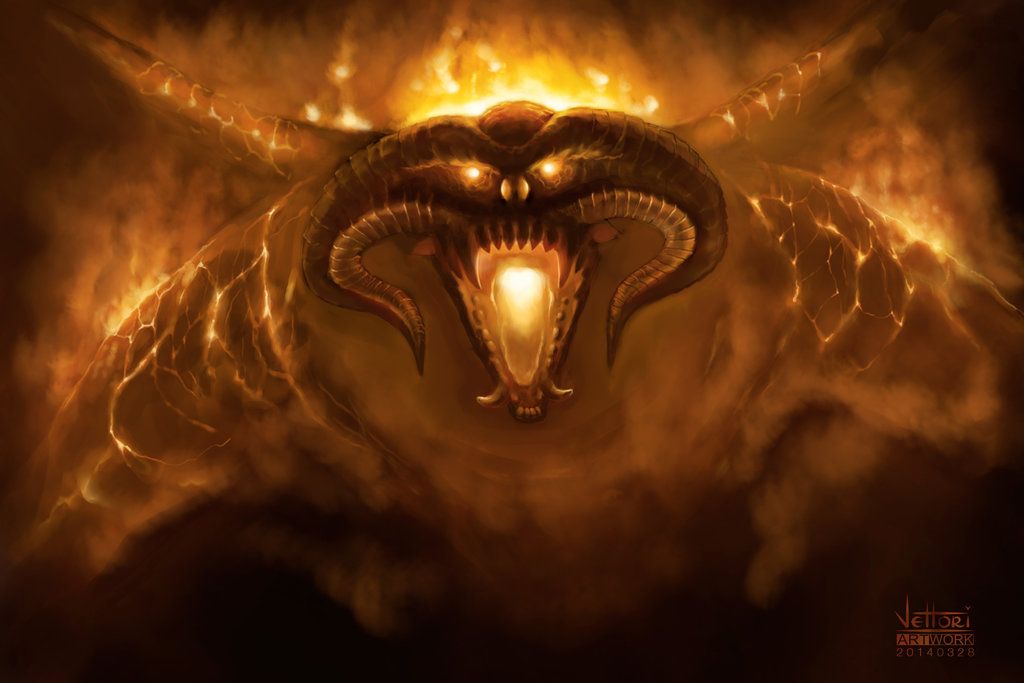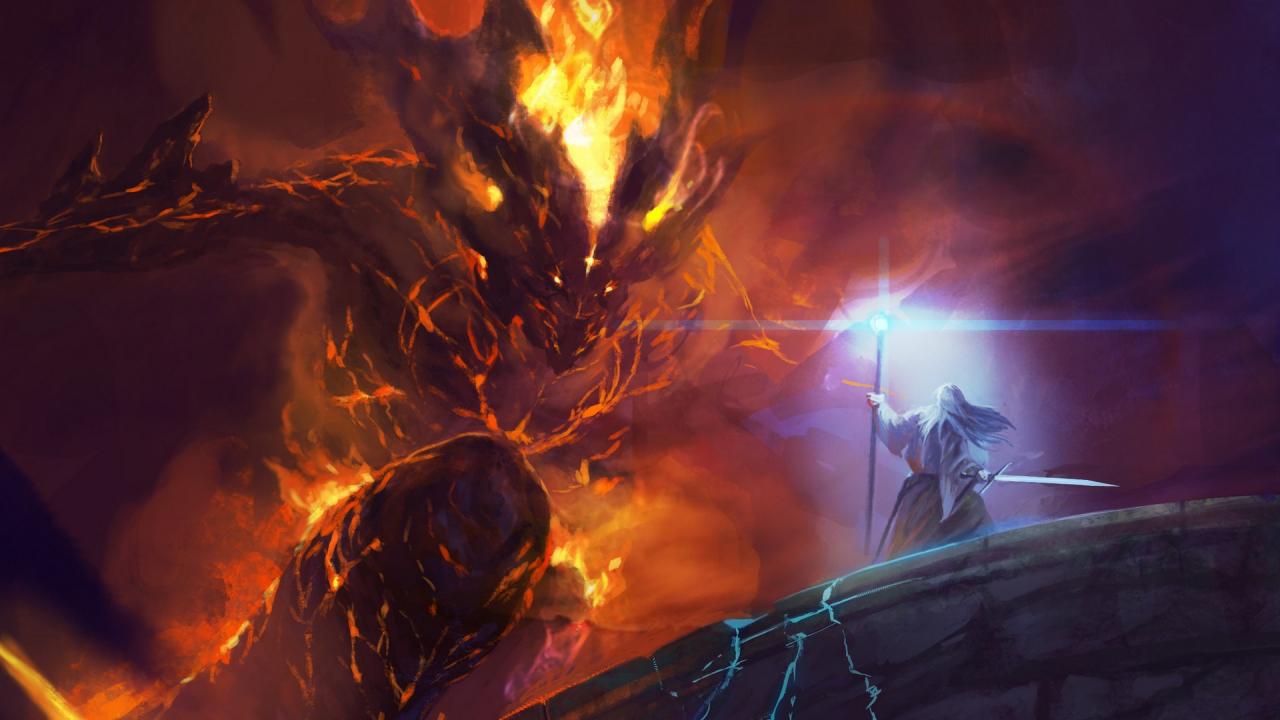Balrog
| Species | chthonic (demon) |
| No. Appearing | 1 |
| Behaviour | malevolent |
| Range | Abyss, ruin, subterranean |
| Size | 12 ft. tall |
| Weight | 3,100 lbs. |
| Intelligence | 14 to 16 |
| Armour Class | -7 |
| Hit Dice | 12+8 |
| Action Points | 5 |
| Max. Stride | 12 |
| THAC0 | 14 |
| Hp/Die | 3d4 |
| Attack Forms | 3: two claws; long sword or whip |
| Damage | claw (3–18); long sword (4-24); whip (5-15) |
| Special Attacks | +2 weapon to hit, buffeting, cause fear, darkness, detect invisibility, detect magic, dispel magic, gate, immunities, long sword +3, magic resistance, possession, pyrotechnics, suggestion, symbol, telekinesis, teleportation, ultravision, whip |
Balrogs are immense demons standing between 12 and 14 feet tall, characterized by their horns, demonic features and tattered wings. Their bodies have the texture of broken lava, with cracks that emit a fiery glow, indicating a blazing heat generated from within. This internal heat radiates outward, further emphasizing the creature's fiery nature. The Balrog's low armour class results from its composition, being partly made of softened, not entirely molten rock.
In temperament, balrogs are surprisingly taciturn and aloof, displaying a marked disdain for collaboration or interaction with other creatures, even other demons. They rarely, if ever, act in concert with others, preferring complete autonomy in their actions and decisions. Their solitary nature stems from an intrinsic desire for isolation, which they find comforting and empowering. This preference for solitude drives them to occupy the deepest, most isolated chasms of the Abyss, where few other beings dare to venture. Loneliness is not merely tolerable for a balrog — it is their greatest pleasure. The vast, desolate expanses of the Abyss provide the perfect environment for their brooding, as they can roam unchallenged and unobserved. Despite their power, Balrogs rarely seek dominion or leadership over others, considering such roles beneath their dignity and a distraction from their preferred existence.
However, their solitary demeanor should not be mistaken for passivity. When disturbed or provoked, they become ferociously aggressive, their fiery rage capable of consuming even the most formidable opponents. Their taciturn nature extends to a disdain for unnecessary conversation, and they are known to answer insults or challenges not with words, but with immediate and overwhelming violence.
Though they shun interaction, Balrogs are not without intelligence or cunning. They are deeply knowledgeable about the chaotic geography and hazards of the Abyss, and their reclusive lifestyle allows them to develop unique and esoteric knowledge of the dark realms they inhabit. Only the most powerful demons, deities, or mortals with extraordinary resolve dare approach them, whether to seek aid, bargain, or challenge their might.
Mythology & Origin
Balrogs do not originate from Earthly culture or mythology but instead stem from beings known as the Ainur (demi-gods). The Ainur were created by Eru Iluvatar, one of the many names for the supreme being of the universe. These divine beings originally inhabited Silvanie, a land on Outer Earth, a vast flat disc floating adrift in the Astral Sea. This realm is also the ancestral origin of the elves, who migrated to Earth from Silvanie approximately 50,000 years ago.
Among the Ainur was Melkor, the most powerful and ambitious of their number. Through his influence, Melkor corrupted many of the lesser Ainur, transforming them into the maiar, semi-divine entities who once freely roamed the multi-universe. Balrogs comprised a significant part of these maiar, becoming fearsome manifestations of chaos and destruction. Their transformation marked a shift from beings of order and light to those of fire and shadow, embodying Melkor's rebellion against divine authority.
During the War in Heaven, a great cosmic conflict, many evil beings were cast out and restricted from entering the blessed planes. This divine decree confined them to the lower planes, realms dominated by chaos and evil. The balrogs, who harboured a deep hatred for order and authority, chose to retreat into the infinite layers of the Abyss. There, they found a domain that aligned with their nature — one where endless chaos and unbridled power could reign. Unlike many other demonic forms, balrogs are not permanently bound to the Abyss. Their connection to the Ainur grants them an unusual autonomy, similar to that of demon princes. They can leave the Abyss at will, though they remain unable to enter the divine planes, such as Heaven or Elysium.
Balrogs occasionally appear on the Prime Material Plane, often drawn by powerful summoning rituals or events of cosmic significance. Their presence on the Prime Plane is rare but devastating, as their might and fiery wrath leave destruction in their wake. Because of their origins as corrupted Ainur, balrogs retain a distinct nature that sets them apart from common demons, making them both feared and enigmatic.
Advantages
Balrogs are immune to sleep and charm magic, whatever the source, as well as attacks from cold, fire, electricity or gas of any sort. They are able to teleport. They are able to be hit only by weapons with a bonus of +2 or greater. They possess a natural ultravision. They are able to produce darkness at will, encircling their selves with a 20 ft. radius of inky blackness, which can be dispelled only with dispel magic. They have a high magic resistance of 75%.
If pressed, balrog have an 70% chance of gating another demon (roll a d6): either a glabrezu (1–2) or a nalfeshnee (3–6).
Balrogs are also able to perform detect magic, detect invisibility, telekinesis and suggestion, cause fear or pyrotechnics, dispel magic or use a symbol of hopelessness or pain.
All these abilities can be performed at will, requiring only 1 action point to perform. However, no more than one such power may be performed per combat round. A power cannot be employed if it is already active.
Balrog cannot fly, but in combat they will beat their wings rapidly (buffeting), causing 2–5 damage to all within three hexes (no saving throw). This buffeting will also sweeping their enemies in partial flames. This will singe hair and require that fragile items like paper, loose clothing (capes and cloaks), or thin wood (arrows, bows, javelins) must make a saving throw against magical fire.
In the use of weapons, the balrog favours a long sword that functions as a flame tongue, as well as a whip of many twisted metal cords. These weapons, too, are enlarged, augmenting the amount of damage they cause.
The long sword causes 4–24 damage and is +3 to hit and damage. Any creature struck by the weapon must make saving throw for worn or carried clothing, leather and wood (such as shields); clothing that fails will be singed and ruined; leather and wood will break or cease to be of effect. The sword can strike within two hexes of the balrog.
The whip, or cat-of-nine, causes 5–15 damage (2d6+3). When struck, the target must make save against petrification or be stunned, regardless of the damage sustained. The demon will then pull the target to the nearest edge of its own hex, causing an additional 2–12 damage to the target from the flames of the demon's body. The whip can strike within four hexes of the balrog.
Balrogs may not possess creatures who are aware of what they are facing; however, an unconscious creature may be possessed and used as an outer shell to protect the demoness.
Dweomercraft
Summoned balrogs are extraordinarily angry upon their arrival, resenting the disturbance of their solitude. However, if the summoner, within three sentences, offers a compelling promise of a peculiar place of refuge on the Prime Material or Astral planes — such as a dungeon lair or a deserted castle — the balrog will pause to listen. Balrogs are particularly suited to guarding such locations, provided they are remote, desolate and devoid of nearby inhabitants. Once established in a suitable lair, a balrog may remain content for centuries, thriving in isolation.
If the summoner seeks the balrog's protection over a precious item, this purpose should be made clear during the negotiation. The balrog will willingly act as a guardian for the item, defending it and the lair against intruders with brutal efficiency. However, the balrog dislikes venturing outside its refuge and will expect the summoner to handle external nuisances, such as humanoid settlements or other creatures encroaching nearby. In such situations, the balrog will summon the summoner, often without notice, to address these problems. This dynamic positions the summoner as a de facto "landlord" responsible for resolving external threats, while the balrog focuses on annihilating any direct invaders into its domain.
While the arrangement benefits both parties, the summoner should remain cautious, as the balrog's volatile temperament and disdain for interference make it a dangerous ally to maintain.
See Bestiary

